How to freeze celery for the winter and is it possible to preserve its beneficial properties?
Celery is a seasonal vegetable, so the issue of preparing this “must-have” for those losing weight and aromatic ingredient for meat broths for the winter is especially relevant. One of the best ways to preserve the healthy composition and spicy taste of the product is freezing. We will tell you how to do this correctly below.
Is it possible to freeze celery for the winter?
Freezing is the best option for long-term storage of vegetables. The procedure has the following advantages over other harvesting methods:
- does not require the addition of preservatives - salt, sugar and vinegar - therefore, the frozen product in taste, color and aroma is almost no different from the fresh one, except for the reduced moisture content;
- unlike drying, freezing is easy and quick to do at home;
- Celery can be stored in the freezer for up to 12 months.
The disadvantage of this method is that when defrosted, celery loses its elasticity and is not suitable for preparing salads. However, in soups and other hot dishes this minus is almost unnoticeable.
How to freeze correctly
If you simply put celery in the freezer without preliminary preparation, it will turn into an unappetizing lump of ice, and after defrosting it will be very problematic to wash and clean. Vegetables that are infected with disease or have elements of rot can spread the infection throughout the freezer and cause an unpleasant odor that will be difficult to get rid of.
To avoid such problems, celery is carefully selected and prepared according to the type of vegetable and how it will be used after defrosting.
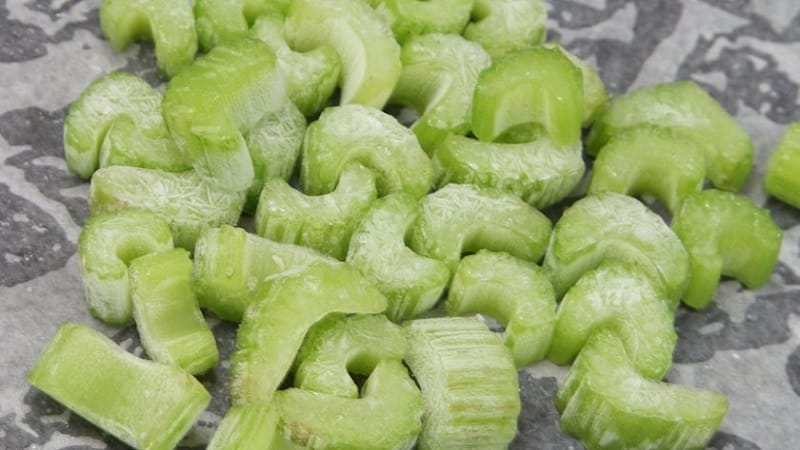
Preparing for freezing
Before freezing, celery is washed and cleaned of hard veins and damaged fragments. Then let it dry so that the excess liquid does not turn into ice.
Celery can be frozen completely or chopped in any convenient way.
Blanching extends the shelf life and improves the appearance after defrosting, that is, briefly immersing the vegetable in boiling water. This procedure helps to preserve as much as possible the original appearance and aroma of the petiole and celery root.
Rules for freezing celery
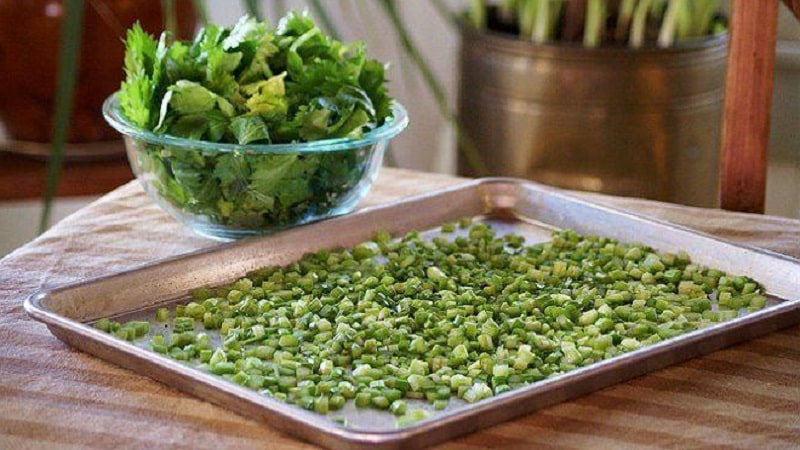
The freezing procedure depends on the type of celery being prepared.
The vegetable has three varieties:
- root is a massive round-shaped root crop;
- petiole is grown for its juicy and fleshy stems;
- leafy is valued for its frequently renewed lush green leaves, saturated with essential oils; it does not form a root vegetable and has thin stems.
The leaves of the petiole and root varieties are also edible.
Reference. It is better to blanch root and petiole celery, and put leaf celery in the freezer, chopped or in bunches.
Sheet
The leaves are cut from the stems, washed thoroughly and allowed to dry, spread in one layer on a towel. Then finely chop and place in a bag or container for freezing. After just a couple of hours in the freezer, the leaves will harden.
Reference. The stems can be frozen separately and used to make vegetable and meat broths.
There are several alternative ways:
- Freezing chopped greens with added water in ice cube trays.
- Instead of water, some housewives fill molds with celery leaves with vegetable oil.
- The greens can be mixed with butter, placed on foil and frozen by rolling them into a tube. like this workpiece do not defrost, but cut off the required portion and add it to various sauces or spread it on bread.
Chereshkova
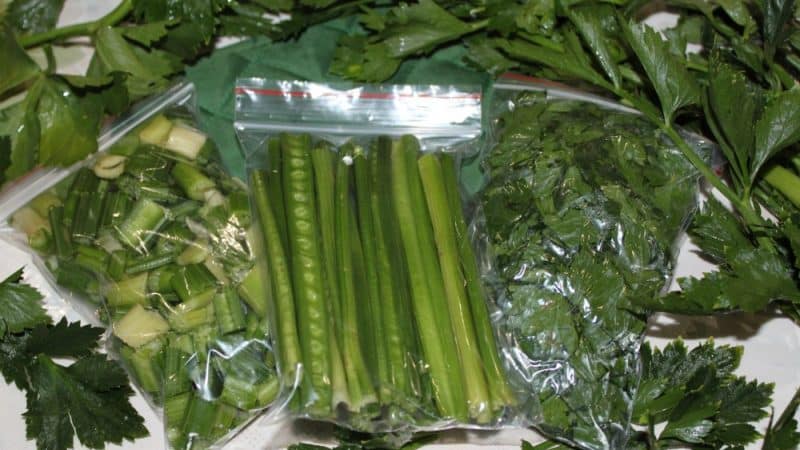
For freezing, juicy fresh stems are selected, rough veins and damage are removed. If necessary, dirt in the recesses at the base is scraped off with a knife or a stiff brush.
Blanch the chopped celery. To do this you need:
- Bring water in a large saucepan to a boil.
- Place vegetables in boiling water and leave for 2-3 minutes.
- Remove celery with a slotted spoon and cool in cold water with ice. When properly blanched, the stems will retain their green color and crisp texture.
Dry the blanched vegetable. Spread in a single layer on a hard, flat surface such as a cutting board or tray and place in the freezer. After 12-24 hours, the pieces will harden, then they are poured into a container or bag for storage. This method will help save space in the chamber and avoid ice on the product.
Reference. Celery, even frozen, has a very strong aroma, so store it in an airtight container.
Root
The root vegetable is washed and the thick skin is removed. You can chop the vegetable in any convenient way: cut into circles, strips or cubes, grate on a coarse grater. Like petiole celery, it is advisable to blanch root celery to preserve the taste and benefits of the product.
Blanched and dried slices are first frozen, laid out in one layer, then packaged in containers for further storage.
Attention. Avoid buying root vegetables cut in half. It may be infected with a disease, signs of which are visible on the cut fragment.
Bunch freezing
Leaf celery can be frozen in bunches:
- Select elastic stems with fresh leaves.
- Rinse thoroughly and dry.
- Form a bundle and wrap it in several layers of cling film or foil.
- Freeze at -18°C or below.
It is convenient to use greens frozen in this way when preparing various broths - there is no need to strain the liquid, the bunch is easily removed with a slotted spoon.
Stems
Uncut stems are frozen in the same way as celery bunches - packed in film or foil.
Celery Soup Mix
The soup set depends on the taste preferences and imagination of the hostess.
Celery goes well with the following vegetables:
- bell pepper;
- cauliflower or Brussels sprouts, broccoli;
- green pea;
- green beans;
- tomatoes;
- carrot;
- zucchini.
These ingredients, except the tomatoes, are blanched and then frozen.
How to freeze celery
Celery is frozen:
- in plastic containers - it is desirable that they are hermetically sealed;
- vacuum bags - in them vegetables do not lose moisture and are not covered with frost;
- freezer bags with a ziplock (fastener) - it is easy and convenient to take the product out of such containers; they take up less space than containers;
- ordinary plastic bags - choose thick bags without holes;
- cling film and foil are an option for storing small portions, whole stems and bunches.
When choosing containers, follow the recommendations:
- It is recommended to freeze a portion for one meal. This makes the product more convenient to use and will not be subject to temperature changes.
- Containers must be labeled with the date of freezing in order to have an idea of the shelf life of the product.
- For compactness, air is pumped out of freezer bags - this can be easily done using a drinking straw.
Useful properties of frozen celery
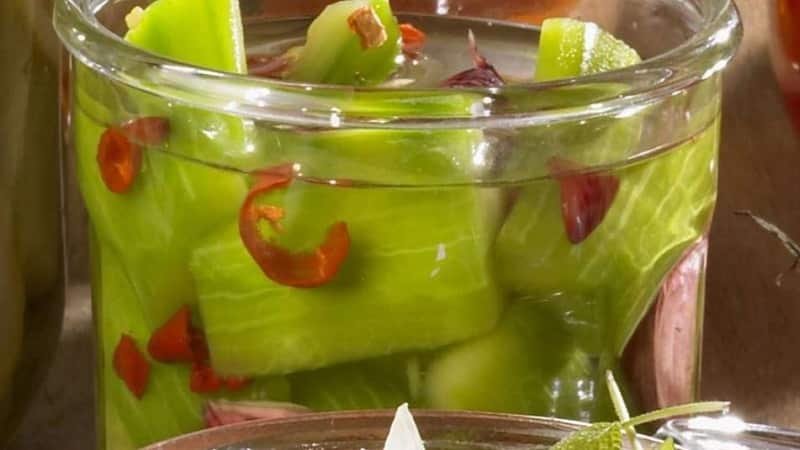
Celery prepared for the winter will diversify the menu during the cold season and enrich the diet with useful substances. The composition of the frozen product retains from 80 to 90% of the vitamins and up to 100% of the minerals contained in the fresh vegetable.
Celery is a superfood for weight loss. It contains fiber, which prevents the deposition of fat reserves. In 100 g - only 16 kcal (greens and stems) or 32 kcal (root).
Celery has beneficial effects on the body:
- stimulates the gastrointestinal tract;
- useful for diabetes;
- regulates the functioning of the cardiovascular system;
- increases performance;
- stimulates mental activity, calms the nerves;
- has an antiseptic and diuretic effect;
- considered a natural aphrodisiac.
Vegetables can only be defrosted once - before cooking. Repeated freezing will negatively affect the quality of the product.
How long can frozen celery be stored?
Shelf life depends on pre-treatment, cutting method and storage conditions:
- The finer the cut, the faster the product will lose its quality. Celery frozen with whole cuttings will last up to 12 months; grated root vegetables will last up to 6-7 months.
- Blanched vegetables last longer than unblanched vegetables. For comparison: chopped stems without blanching - 2-3 months, blanched - 10-12 months.
- An optimal temperature of -18ºС will help celery stay fresh throughout the year. In warmer conditions (about -10ºС) the period is reduced significantly.
Try to freeze foods at the same time - adding fresh “brethren” to the freezer increases the temperature and shortens the shelf life.
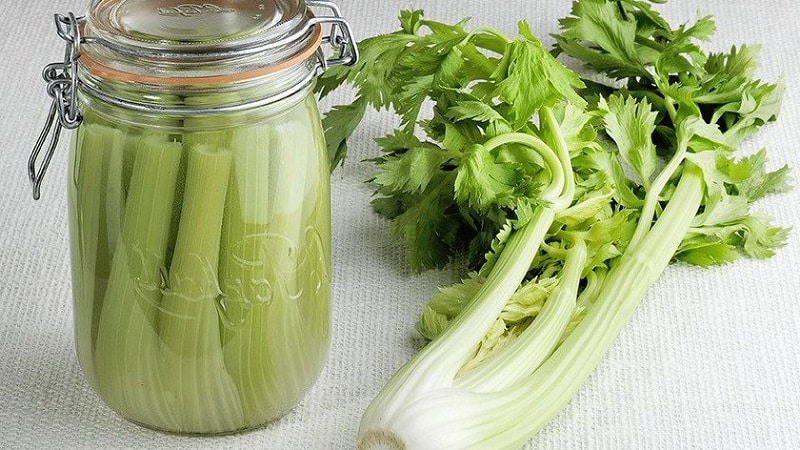
Lifehacks for freezing celery:
- It is advisable that the freezer has a “No Frost” system, then you don’t have to be afraid that the celery will freeze.
- If you make the freezer bags flat and place them vertically in the chamber, they will be easier to remove.
- Not only the vegetative parts of the vegetable are frozen, but also the juice squeezed out of it, for example, in ice cube trays.
- There is no need to defrost celery before adding it to hot dishes: just add it to simmering broth or stew.
Conclusion
Frozen celery has a long shelf life and is easy to prepare. In this form, the product retains its beneficial properties and taste. It is used as a seasoning for soups and in weight loss recipes.